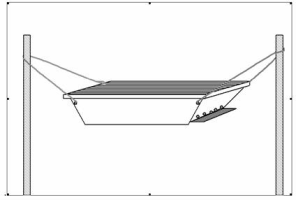Credits:Biovision-Infonet
Quality honey starts with a good apiary. An apiary is a place where small groups of beehives are kept. A good way to begin beekeeping, especially in Africa, is to bait an empty hive to attract a swarm. Set up a hive and either rub it inside with some bees wax or lavender (plant leaves) to give it an attractive smell, or leave some attractive food for the bees. Granulated sugar or cassava powder will work. You could also put some honey on the top of the top bars. The bees will not be able to get at it and take it away to another hive, but the scent will remain and attract them. This will only be successful in areas where there are still plenty of honey bee colonies. Another option is to transfer a colony from the wild into the hive. The wild colony will already have a number of combs and these can be carefully tied on to the top bars of the hive, making sure that you include the brood combs and the queen. One of the best ways to get started in beekeeping is with the assistance of a experienced local bee keeper.
The following steps are necessary in starting a good apiary:
Step 1: Site selection
- Easy to access
- Away from human activity and noise
- Safe from thieves
- Near a place where bees can find water
- Near flowers, and trees that produce flowers
- Protected from strong sun and winds
- Usually a place that is not useful for other activities such as crop farming
Step 2: Site Preparation
- Clear obstacles and vegetation around hives to allow easy movement
- Protect against unwanted visitors such as thieves and large animals
- Plant nectar-producing plants to provide forage
Step 3: Placing the hives: Things to observe
- If you decide to use stands they should be at least 1 metre high. They must be made of strong, termite resistant wood, so they will last. Live stands will not rot and you can use types of wood that will grow easily into new plants when stuck in the ground. Otherwise, the legs of stands must be covered with grease or put in tins of oil so ants cannot climb into the hive.
- Use suspension wires if honey badgers are a danger. The wires need to be well greased to keep ants away. The suspension wires must allow the hive to swing easily to keep animals away.
- Hang hives at least 1 metre from the ground.
- Leave enough space (10-20 m for scutellata bees) between hives to make it easy to work without disturbing bees in other hives.
- Make sure the hive entrances face away from footpaths.
- Limit the number of hives.
Step 4: Hive Preparation and Maintenance
The hives need to be clean and to contain a good bait to attract honeybee swarms to live there

(c) Apiconsult
- Use plenty of bees wax around the inside of the hive and at the entrance. A top bar with a fresh bees wax starter strip is excellent for attracting bees. Bees are also attracted by a comb containing brood
- If possible use wax starter strip on each top bar. This will force the bees to build in the desired direction
- The bees like the odour of some leaves, which are always known locally and are sometimes used as extra baits
- Inspect hives regularly to check if bees have moved into them.
- If there are no bees check hives are clean and dry and that no pests, such as ants and spiders or snakes have moved in
- Add more wax bait if needed. The best time to colonise hives is when bees are swarming or migrating
- Discuss with experienced local beekeepers when the best colonising times will be